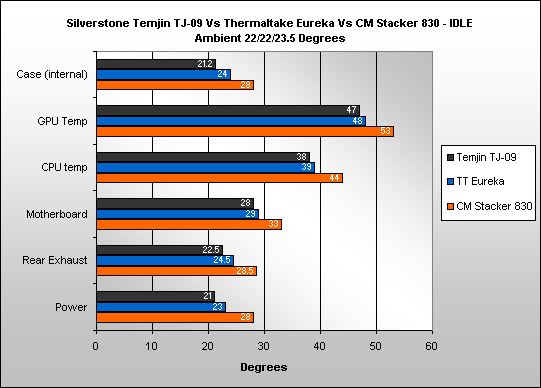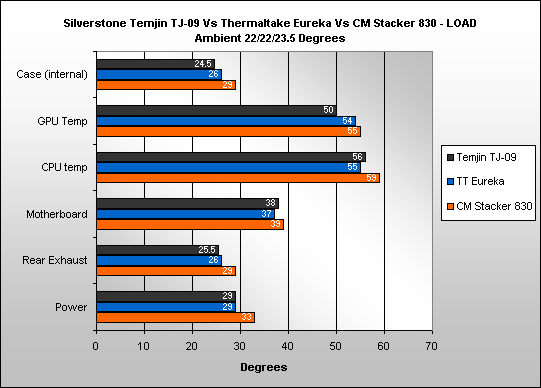Burn, baby, burn...
For all our reviews we have a preset component list that's designed to push any chassis to the limit. This is intentional and is to show just how capable any chassis is when fitted with the hottest hardware out there.We fitted the TJ-09 up with the following components:
| HEXUS Chassis test equipment specification | |
|---|---|
| Motherboard | Intel 955XBK |
| Processor | Intel Pentium Extreme Edition 840 (3.2GHz, Smithfield core) |
| Memory | 2GiB (2 x 1GiB) OCZ DDR2 PC4200 Value Pro Dual-Channel |
| Graphic Card | ASUSTek GeForce 6800 256MiB Ultra PCIe |
| Power Supply | Antec Neo HE 430W |
| Hard Drive | Seagate Barracuda 160GB SATA |
| Optical Drive | Pioneer 110 DVD Re-Writer |
If there is one thing to note it's that the TJ-09 could prove to be quite noisy with all the available fan slots filled. As it is, however, our standard configuration was perfectly acceptable in the acoustic department.

At idle the Temjin TJ-09 managed to wipe the floor when compared to the Stacker 830 from Cooler Master, but the Thermaltake Eureka did give it a run for its money in a couple of readings.
Of course, the key reading as far as the TJ-09 is concerned is the GPU temperature. Considering its dedicated graphics cooling we expected to see pretty good performance in this area. Surprising, then, that the Eureka from Thermaltake was only a single degree behind.
Another area that surprised was the ambient case temperature; it seems the clear channel of air proves to have an effect on the chassis as a whole rather than the graphics specifically.

Under load the TJ-09 really started to shine. The GPU reading was a whole four degree better than the nearest competition and, evidently, it seems that the graphics cooling solution comes into its own under load; not surprising considering its spin rate is controlled by the motherboard.
The internal case temperature continued to impress, especially over the Stacker 830. This fact is surprising (which seems to be the watchword here) when you consider the number of meshed areas that chassis has.
Overall, then, the thermals show the solution SilverStone has implemented works, even if it really only comes into its own under load, but that’s not such a bad thing really, is it?









